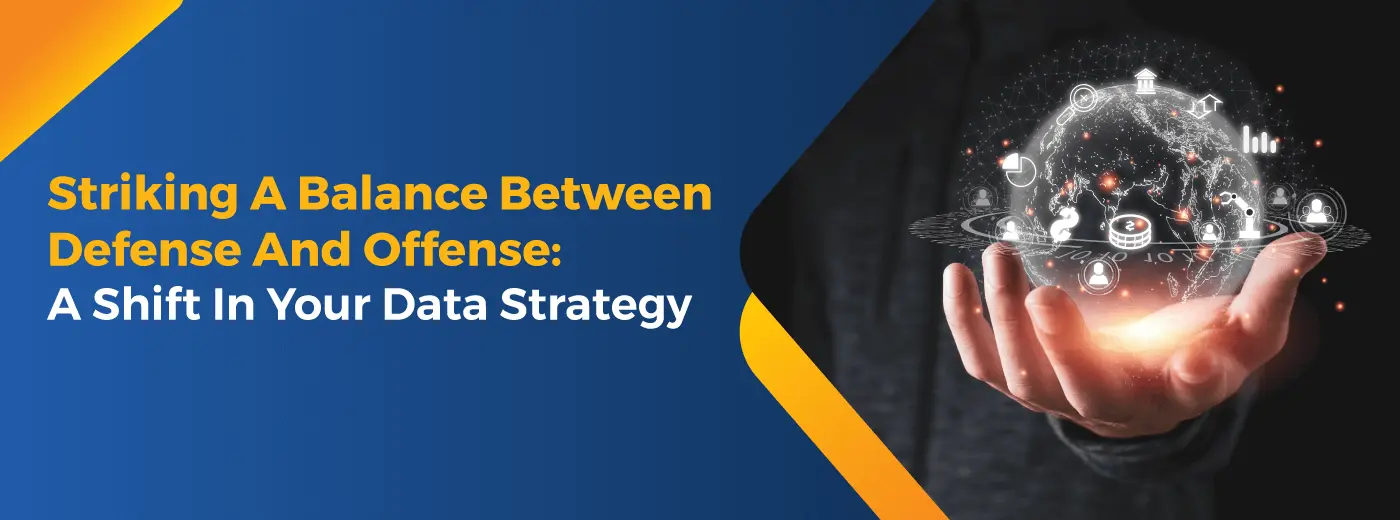
Sign up to receive latest insights & updates in technology, AI & data analytics, data science, & innovations from Polestar Analytics.
What do you think is most significant for your organization: finding and exploiting information opportunities or identifying and mitigating information problems? Data defense and data offense are relatively known concepts brought into the limelight by the explosion of big data. In the current scenario, businesses recognize the many perks that come with almost limitless info, but prioritizing what your company does with that information can prove difficult.
Close your eyes and think of your preferred sports team. Just imagine you like your local football team for a sec. While it's really true that a professional sports team can't get by without both good defense and good offense, your favorite team probably has a reputation for being better at one than the other. It might have made a name for itself as an exceptionally high-scoring side, or a miserly defensive unit may allow it to win despite not scoring a spectacular amount.
In the same manner, there's no single road map to success for your company as far as data strategy is concerned. Some organizations will lend themselves to building from a robust defense; others will do best to put more focus on offensive measures. Identifying where your organization sits on the data defense/offense spectrum will guide your data strategy, ensuring that it provides the most significant amount of value possible. So what do you require to consider when striking a balance between the two? Before we go ahead, let's understand the primary difference of each approach.
Our assessments and roadmaps will provide you with a successful plan that encourages the business and IT team to work together, with the right methodology and tools to achieve successful adoption.
Talk to our Data Strategy ExpertsData offense and defense are distinguished by different business objectives and the activities designed to address them. An offensive-minded organization tends to be more business conscious and focus on tactical and strategic outcomes to increase profitability, visibility, revenue, and customer satisfaction. They typically generate omnichannel customer insights utilizing data science mechanisms such as predictive analytics and leverage machine learning for automation that can forecast trends quicker. Data offense organizations are often ones that work with fewer regulator restrictions (i.e., retail). Therefore, they tend to be more flexible with their data and are more interested in multiple versions of the truth (MVOT).
A defensive-minded organization, customarily ones that operate in a highly regulated environment such as healthcare and financial services, leans toward a more technical plan of attack to minimize downside risks. Their activities generally include ensuring regulatory compliance via mandated governance initiatives that protect data integrity used for reports like employing business intelligence (BI) tools, financial statements to alert personnel of suspected fraud, and support apps that prevent theft. Data defensive companies put a premium on control by optimizing data extraction, standardization, and user access so that there is only a single source of truth (SSOT).
Every organization requires offense as well as defense to succeed, and striking the right balance is tricky. The challenge for CDOs and the rest of the C-suite is to set up the appropriate trade-offs between offense and defense, assuring the best balance that supports the company's overall strategy. Here are some of the elements of Data strategy.
Defense and Offense often need varying approaches from the data management and IT organization. The offense is about partnering with business leaders concerned with strategic initiatives. Leaders are always happy to join forces on trade promotion spending and optimizing marketing. Defense, on the other side, is day-to-day and operational.
Chief Data Officers find that their ideal data strategy puts more focus on flexibility. It's not shrewd to default to a 50/50 split instead of making well-thought-out trade-offs. To ascertain an organization's existing and desired positions on the offense-defense spectrum, the CDO must keep in mind its regulatory environment, overall strategy, the data abilities of its competitors, the maturity of its data-management practices, and most significantly, the size of the data budget.
Irrespective of what industry an organization belongs to, its position on the offense-defense spectrum is hardly static. As competitive pressure intensifies, an insurer may decide to focus more on offensive activities. For instance, a hedge fund may find itself in a complex regulatory environment that demands rebalancing its data strategy towards defense. How an organization's data strategy changes in velocity and direction is a function of its overall strategy, competition, culture, and market.
We focus on efficient decision-making and leveraging best practices to guide Data Strategy engagements. Let us help you decide whether the data strategy fits in before your project begins.
Get analytics consultingWhether you tend towards the Bear Bryant' defense wins championships' school of thought or the Vince Lombardi 'the best defense is a good offense' camp, the more focused you stay on data strategy, the more prominent your organization's particular formula for success will become.
The data strategy framework will emerge more pertinent as technology grows more pronounced. The write-up is to let you know that you will need to execute both offense and defense at least well enough. Swinging too far one way will either impede your organization's growth or open it up to (entirely avoidable) disaster. Like any professional organization, it's wise to first focus on developing your defensive and offensive fundamentals and then build your greater data strategy from there.
At Polestar, we have a team of professional consultants who carry years of extensive data analytics consulting experience. Our proven competency on leading data & analytics platforms helps us consult with a technology-agnostic approach and recommend an optimum strategy based on your existing setup. Book a session today!
About Author

Content Architect
The goal is to turn data into information, and information into insights.